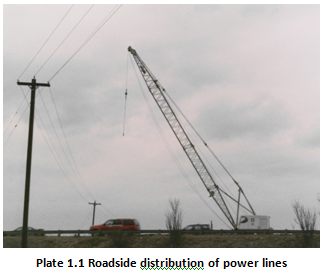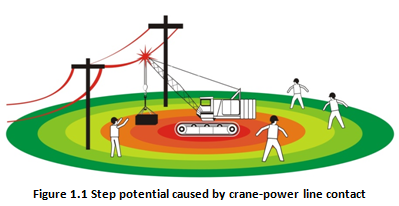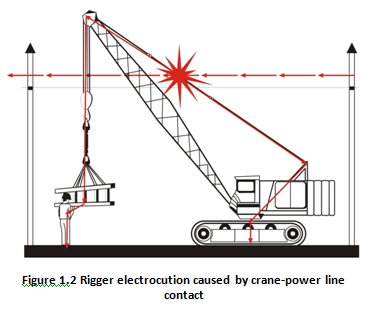1.1 Motivation
The US Department of Labor (2007) demonstrated that crane power line contact has been the primary killer on construction sites in the USA for the last 20 years. Crane power line contact occurs when a crane comes into contact with an energised power line. Suruda et al (1997) state that electrocutions amount to approximately 44% of total construction fatalities when a crane was involved and Morgan (1992) estimates 100 power line incidents occur each year.
1.2 The Problem
The Code of Federal Regulations (2002) stipulates that no part of a crane, or its suspended load, was allowed to work within 3.05 metres (10 feet) of a 50 kilovolt (kV) line and to effect this a dedicated spotter is used to warn the crane operator when any part of the crane breaches the 10 ft distance. Cunitz and Middendorf (1985) put forward several explanations for why a crane could hit an apparently harmless power line; these include poor lighting conditions, over familiarity on the part of the operator, poor training and bad judgement, but that the primary cause was that human eyes are unable to gauge the distance between the crane and power line against an undistinguished sky, plate 1.1. Cunitz and Middendorf observe that the lack of either shadow or other objects against which to make a visual comparison is significant in creating this effect.

Turner (2004) expresses 20/XX as a measure of visual ability, and can be expressed with 20 ft (6.09 m) as the numerator and the denominator XX being the ability to recognise characters measured in minutes of an arc. On this scale of measurement 20/20 is considered normal, 20/40 is half normal and 20/10 twice normal. Turner suggests a dedicated spotter, with uncorrected vision, should have eyesight of at least 20/13, which is 30% better than normal.
BC Hydro (2003) suggest that when a crane contacts a power line the ground underneath the crane will become energised as the power flows from the power line down the crane, through its out-riggers and tyres, to the ground. At some distance from the crane, which is a function of soil type and moisture, the ground will be at zero volts, figure 1.1.

BC Hydro (2003) suggest that a person within this area is in direct danger either by touching any conductive part of the crane or even walking across the potential gradient. This situation can result in fatalities due to the ‘step potential’, which is the voltage difference between the two feet, being sufficient to pass a current through the heart causing fibrillation. Their approved and safe manner to exit this danger area is to shuffle or hop. In this way no potential gradient or difference will exist between the two feet, as they will be at the same physical point hence the same voltage. Mousa (1990) suggests this area of danger extends to a distance of 1.2 m from any conductive part of the crane touching the ground when energised with 25 kV.
MacCollum (1993) identifies three types of personnel in contact with a crane: the driver, the bystander and the rigger. “Oiler” is a generic name for any bystander in contact with the crane and ground. The rigger attaches the load to the hook of the crane and often guides the load being lifted by means of a line called a tag line. MacCollum quotes that in 70% of crane-power line contacts the rigger was electrocuted as current passes from the crane-power line contact through the crane and rigger to earth, figure 1.2.

The crane operator sits in a metal cab, effectively a Faraday cage, and the power flows around the cab and thus the crane operator was safe. Hitting the power line often disables the controls of the crane and so the crane operator was unable to swing the crane away from the powerline. The crane operator must have the self-discipline not to leave the cab until the power was turned off by the electric utility whilst watching, yet unable to help, co-workers being killed. The crane operator’s situation becomes more dangerous if the crane catches fire, forcing the operator to jump without touching the crane and ground simultaneously. The crane operator subsequently has to leave the area in the safe manner described above to avoid ‘step potential’. The oilers are almost always killed, or badly injured, unless the power line contacted the lifted load below an insulating link.
Accidents of this nature also give rise to many serious injuries each year including burning off all limbs, plate 1.2. This type of crane accident occurs in a range of countries, including the USA, where distribution power lines are carried on roadside poles often using unsheathed wires, plate 1.1. In the UK these same distribution power lines are usually buried in the road with the exception of rural situations.

1.3 A proposed solution
A proposed solution to the problem of electrocution from crane power line contact is a Proximity warning systems, advertised as having the capability of alerting operators when they approach too close to a power line, have been commercially available for 30 years. Such systems have not found widespread acceptance due to perceived performance deficiencies and, in part, to a lack of regulatory requirements. Hipp (1982) for Department of mines documented some serious performance limitations. Proximity warning system manufacturers claim to have substantially improved product performance since then. Recent OSHA efforts are underway to improve the 29CFR Crane and Derrick Standard. The proposed language allows the use of proximity warning alarm systems as a means of maintaining required clearance distances from power lines, provided such systems are approved by a nationally recognized testing laboratory. To allow approval by a third-party testing laboratory, objective performance data must exist from which to develop a standard for use by such laboratories. NIOSH (2008) sponsored work provided technical data for such a national standard. The standard based upon these tests has been created by CPLSO as CPLSO 15.
References:
- BC Hydro 2004 Workspace Safety On line available at:
http://www.bchydro.com/safety/workplace_safety/7_steps_to_electrical_safety.html - Code of Federal Regulations, 2002. 29 CFR 1926 – Labor. Washington, D.C.: U.S. Government Printing Office
- Cunitz R.J. and Middendorf L. 1985. Problems in the perception of overhead power lines. Hazard Prevention, 21(2), 19-23
- Goff L.E. Automatic reclosing of distribution and transmission line circuit breakers. General Electric Company GER – 2540 A [online] Available at:
- Hipp, J.E., et al 1982. Evaluation of Proximity Warning Devices. Bureau of Mines Final Report, Contract JO188082. Washington, DC: Superintendent of Documents.
- MacCollum D. V. 1993. Crane hazards and their prevention. Des Plaines, IL: American Society of Safety Engineers
- Morgan D. 1992. Deposition Muszynski v. Union Oil Company et al. s.l.: s.n.
- Mousa A.M. 1990. Protecting firemen against fire-induced flashovers. IEEE Transactions on Power Delivery, 5(1): 297-302
- The National Institute for Occupational Safety and Health. 2008. A Performance Evaluation of Two Overhead Power Line Proximity Warning Devices. NIOSH Information Circular 9510: US Dept. of Health and Human Services
- Suruda A. et al. 1997. Crane related deaths in the US construction industry 1984-94. Center to Protect Workers’ Rights, Report D2-97. Washington D.C.:CPWR
